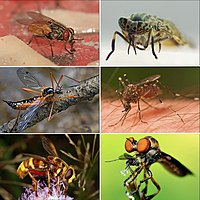
Photo from wikipedia
Insect communities consist of species from several trophic levels that have to forage for suitable resources among and within larger patches of non-resources. To locate their resources, insects use diverse… Click to show full abstract
Insect communities consist of species from several trophic levels that have to forage for suitable resources among and within larger patches of non-resources. To locate their resources, insects use diverse stimuli, including olfactory, visual, acoustic, tactile and gustatory cues. While most research has focused on cues derived from plants and other insects, there is mounting evidence that insects also respond to volatile organic compounds (VOCs) emitted by microorganisms. However, to date little is known about how the olfactory response of insects within and across different trophic levels is affected by bacterial VOCs. In this study, we used Y-tube bioassays and chemical analysis of VOCs to assess how VOCs emitted by bacteria affect the olfactory response of insects of the same and different trophic levels. Experiments were performed using two aphid species (Amphorophora idaei Börner and Myzus persicae var. nicotianae Blackman), three primary parasitoid species (Aphidius colemani Viereck, A. ervi Haliday, and A. matricariae Viereck), and two hyperparasitoid species (Asaphes suspensus Nees and Dendrocerus aphidum Rondani). Olfactory responses were evaluated for three bacterial strains (Bacillus pumilus ST18.16/133, Curtobacterium sp. ST18.16/085 and Staphylococcus saprophyticus ST18.16/160) that were isolated from the habitat of the insects. Results revealed that insects from all trophic levels responded to bacterial volatiles, but olfactory responses varied between and within trophic levels. All bacteria produced the same set of volatile compounds, but often in different relative concentrations. For eleven of these volatiles we found contrasting correlations between their concentration and the behaviour of the primary parasitoids and hyperparasitoids. Further, olfactometer experiments on three of these compounds confirmed the contrasting olfactory responses of primary parasitoids and hyperparasitoids. The potential of these findings for the development of novel semiochemical-based strategies to improve biological aphid control has been discussed. This article is protected by copyright. All rights reserved.
Journal Title: Insect science
Year Published: 2023
Link to full text (if available)
Share on Social Media: Sign Up to like & get
recommendations!